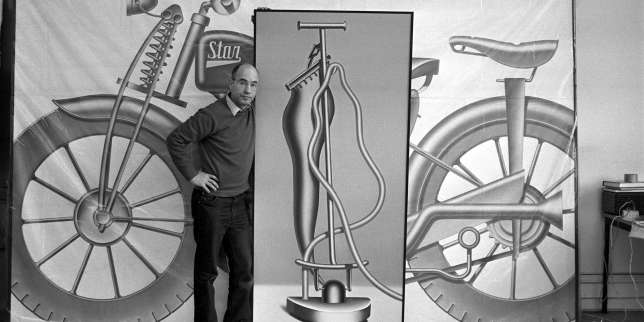The German artist, who was one of many first to inscribe the facility of machines in artwork, died on July 30 on the age of 88.
Subscribers solely
German painter Konrad Klapheck handed away in his sleep on Sunday, July 30, in Düsseldorf, on the age of 88. Having suffered from Parkinson’s illness for a number of years, he had stopped portray.
Klapheck was born in Düsseldorf on February 10, 1935, to artwork historians. His father, Richard, was expelled from Kunstakademie Düsseldorf, town’s academy of superb arts, in 1934 by the Nazis and died shortly earlier than the conflict. Konrad and his mom survived the bombing of Leipzig, the place they’d taken refuge. He then returned to his hometown in 1945. In 1954, he enrolled on the Kunstakademie Düsseldorf and confirmed an curiosity in Surrealism when he visited Max Ernst in Paris that very same 12 months. “I knew Pollock and Wols, I flirted with Artwork Informel, Tachisme and dripping,” he stated in 2005, recalling that interval of his life.
However quite than becoming a member of the pattern, he radically opposed it. On the age of 20, in 1955, Klapheck determined to color a typewriter as precisely as doable. The mechanical topic and the sleek, impartial model have been the precise reverse of the celebration of the gestural and the unconscious, which have been the hallmark of American motion portray and European abstraction. Klapheck was one of many first to deal with this, and to inscribe the omnipotence and omnipresence of machines in artwork, a number of years forward of Parisian New Realism and New York Pop Artwork, which started to emerge in 1960. Though he was conscious of what these artists had in widespread with him, Klapheck nonetheless saved his distance: “I acquired on properly with Klein and Arman. However they did not invite me to hitch them,” he stated.
He didn’t thoughts, as a result of his first solo exhibition, in 1959 on the Galerie Schmela, additionally in Düsseldorf, was successful. He had established his personal model and iconography. With the precision of an engineer, he depicted irons, stitching machines, punch presses, gasoline masks and Swiss Military knives, enlarged on canvases a lot greater than the objects themselves and set in opposition to immaculate monochrome backgrounds. No energy cords or metallic cogs or joints have been lacking. The reference to Duchamp’s “machines célibataires” (“bachelor machines”) was blatantly apparent, no much less so than the reference to the torture machine for condemned prisoners described by Kafka in his quick story “Within the Penal Colony” (1919). With out ever giving in to pathos, Klapheck invented the ironic artwork of technical cruelty.
Shock and unease
When he met André Breton in 1961, Klapheck present in him each a collector and an advocate: Breton wrote the preface for Klapheck’s exhibition on the Ileana Sonnabend Gallery in Paris in 1965; included him in his collection of the ten younger artists most consultant of the interval; and invited him to participate within the exhibition “L’Ecart absolu” (“Absolute Deviation”), which was the final exhibition designed by Breton earlier than his demise. The surrealist tone of Klapheck’s work was all of the extra noticeable given the titles he selected for his canvases, which sound like one thing that De Chirico or Magritte might need created: “The Will to Energy” for a calculator, “The Voice of Conscience” for a machine software and “Splendor and Distress of the Reforms” for a bulldozer. The connections with narrative figuration – with Telemachus particularly – and with hyperrealism have been additionally robust. His work was steadily exhibited in Germany and Paris and infrequently in New York.
You have got 26.6% of this text left to learn. The remaining is for subscribers solely.
Vous pouvez lire Le Monde sur un seul appareil à la fois
Ce message s’affichera sur l’autre appareil.
-
Parce qu’une autre personne (ou vous) est en practice de lire Le Monde avec ce compte sur un autre appareil.
Vous ne pouvez lire Le Monde que sur un seul appareil à la fois (ordinateur, téléphone ou tablette).
-
Remark ne plus voir ce message ?
En cliquant sur « » et en vous assurant que vous êtes la seule personne à consulter Le Monde avec ce compte.
-
Que se passera-t-il si vous continuez à lire ici ?
Ce message s’affichera sur l’autre appareil. Ce dernier restera connecté avec ce compte.
-
Y a-t-il d’autres limites ?
Non. Vous pouvez vous connecter avec votre compte sur autant d’appareils que vous le souhaitez, mais en les utilisant à des moments différents.
-
Vous ignorez qui est l’autre personne ?
Nous vous conseillons de modifier votre mot de passe.
Lecture restreinte
Votre abonnement n’autorise pas la lecture de cet article
Pour plus d’informations, merci de contacter notre service business.














